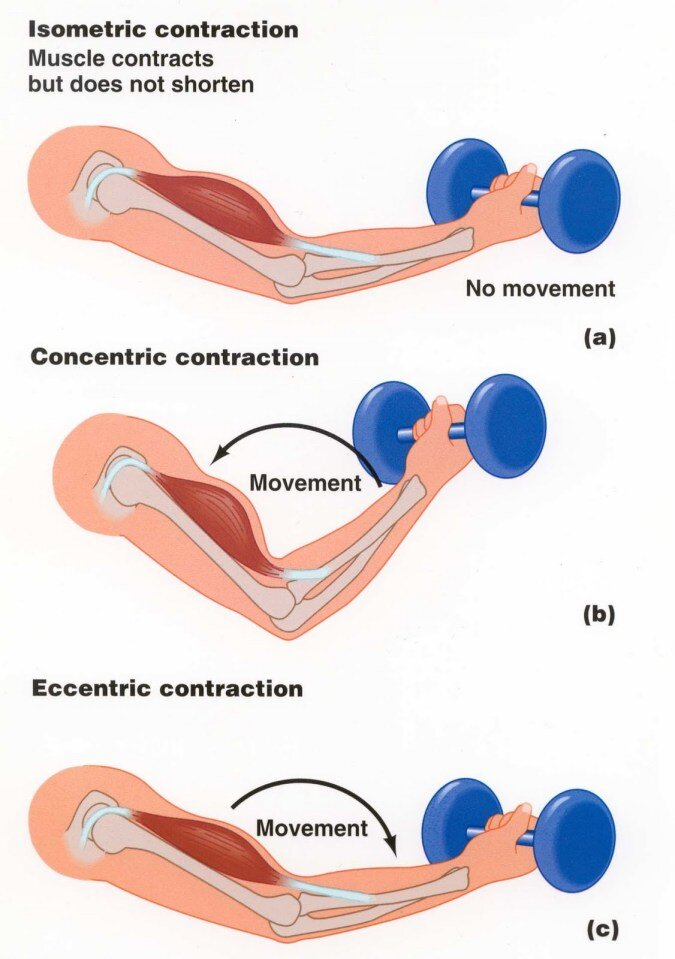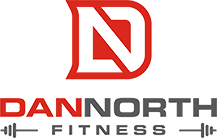There are three ways your muscles can contract.

- Concentrically: This is when the muscle shortens under load while contracting. During a dumbbell curl, for example, your biceps contract concentrically when you curl the dumbbell up.
- Eccentrically: This is when the muscle lengthens under load. For example, during a dumbbell curl, your biceps are contracting eccentrically as you lower the weight down and straighten your arm.
- Isometrically: This is when the muscle contracts but there is no movement or change in the angle of joint involved (also known as a static contraction). So, for example, holding your arm at a 90 degree angle during curls and pausing the motion.
But, that’s not the only type of isometric contraction. There are actually two types of isometrics, both offering their own unique benefits when it comes to getting stronger and building muscle.
1. YIELDING ISOMETRICS
Yielding isometrics is when you’re holding a position and resisting the urge to move, like the example given above. This can be performed with an external object, like holding a dumbbell with your arms bent at 90 degrees, causing an isometric contraction in the biceps.

But it can also be done with no equipment at all, like holding a plank position where you are working your core and the majority of your other muscles to hold your body in position and resist the urge to move.
Whether you use equipment or not, yielding isometrics are a great tool to incorporate into your workouts for a few reasons:
- Safe on the joints: There’s not a whole lot of wear and tear on the joints when it comes to isometric training, actually, it will improve your joint health significantly. Since there’s no movement involved. the amount of stress put on your joints is way lower than other exercises that involve hinging at the joints. Not to say that exercises that involve joint movement are bad (because they’re obviously not and that would be fucking stupid to say) but adding isometrics into your workouts will help improve all of the other movements you perform as a result.
- Teaches optimal positioning and form: There’s something to be said about mind-muscle connection that a lot of people can find huge benefit from when it comes to understanding which muscles should be working during certain exercises and how to perform them optimally. Pausing and performing static exercises helps you create better awareness and start to develop a stronger connection between your brain and your muscles, resulting in better performance when it comes to everything else, not just isometrics.
- Eliminates cheating/momentum: Similar to teaching good form, isometrics also greatly reduce and sometimes eliminate cheating or momentum commonly used in exercises. For example, people love to bench press. People also love their own ego and think that everyone else give a shit how much they’re benching (they don’t).
So you’ll usually see people bringing the bar down about halfway, barely bending their arms, just so they can press the bar back up during a bench press. Or some people might bring the bar down aggressively to their chest and bounce it off their body to gain momentum. Either way you slice it, you’re not getting as much out of the bench as you potentially could.
Adding a simple pause on the bottom of the bench press will:
- Make sure you are bringing the bar all the day down to the chest, causing you to go through the full intended range of motion.
- Eliminate any potential “bounce” or cheating you might get from bring the bar down too aggressively on the chest and using that to get up.
EXAMPLES OF YIELDING ISOMETRIC EXERCISES
2. OVERCOMING ISOMETRICS
This is where things get interesting. Overcoming isometrics is when you are trying to move an immovable object. So rather than trying to maintain a position, like a plank, you are actively trying as hard as you can to move an external object that is not going to move.
Some things you should know about overcoming isometrics…
- They are not for everyone. Not everyone can or should be doing overcoming isometrics. If you don’t have a lot of experience lifting weights, or are battling some nagging injuries that don’t allow to go all out in your training, leave this on the shelf for now.
- They are extremely taxing. Trying to move something that isn’t going to move is pretty fucking taxing, not just on your muscles, but on your nervous system. You don’t want to overdo with overcoming isometrics.
Why should you do overcoming isometrics?
- Maximal muscle activation: Your body knows how to “turn on” a certain amount of muscles. When you lift a weight, your body recruits a certain amount of muscle fibres to perform the movement. The lighter the weight, the less of a need there is to stimulate your muscles. The heavier the weight, the more “back up” your muscles call for in order to perform the exercise. Overcoming isometrics causes your body to engage as many muscle fibres as it knows how to in order to try to move the immovable object. This is great from both a strength perspective, as well as building muscle.
- Nervous system stimulation: Your nervous system is your brain/spinal cord, and it controls all of the cognitive function of the body (basically, it’s how well your brain is able to communicate to your muscles to perform movement). When you lift weights, you want your nervous system to be thinking fast so it is able to apply force. Overcoming isometric exercises teach your nervous system to engage your muscles as fast as possible in order apply as much force as possible. This helps carryover to strength and will help you shatter your plateaus.
- Break strength plateaus: Some people can get stuck in the rut of doing the same old shit over and over again when they go the gym. It can be easy to find yourself in this situation (I have) and not know what to do to break through your plateaus.
For example, trying to increase your bench and not getting anywhere with your progress can be annoying, but it’s usually due to a lack of variety in your approach to training. Using the bench as an example, instead of repping out 3 sets of 10 like you normally do, you can try performing some overcoming reps.
You would have some safeties set up on the rack with the bar underneath, from there, you’re going to press up against the safeties as hard as you fucking can, for about 5-8 sec. This will get your body used to applying as much force as possible, which will help carryover to the bench. - Pre-exhaust: You can also use overcoming isometrics to build muscle, not just strength, and use them as what’s called “pre-exhaust” sets. A pre-exhaust set is when you perform an isolation movement to pump blood to the muscle before performing another exercise that involves movement and targets the same muscle. This helps build a stronger connection to the muscle during the exercise.
EXAMPLES OF OVERCOMING ISOMETRIC EXERCISES
Christian Thibaudeau showing us how to perform the overcoming isometric bench press.
KEY POINTS
- Your muscles can contract concentrically, eccentrically, and isometrically.
- There are two types of isometrics: yielding and overcoming.
- Yielding is when you are resisting the urge to move and trying to maintain a position (with or without equipment).
- Overcoming isometrics are when you are trying to move an immovable object and applying as much force as possible.
- Both are great for building strength and muscle.
If you have any questions about today’s article, please shoot me a message down below!





